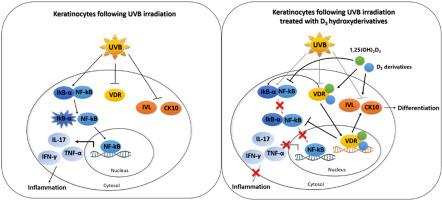Free Radical Biology and Medicine ( IF 7.1 ) Pub Date : 2020-05-22 , DOI: 10.1016/j.freeradbiomed.2020.05.016 Anyamanee Chaiprasongsuk 1 , Zorica Janjetovic 2 , Tae-Kang Kim 2 , Robert C Tuckey 3 , Wei Li 4 , Chander Raman 5 , Uraiwan Panich 6 , Andrzej T Slominski 7

|
UVB radiation mediates inflammatory responses causing skin damage and defects in epidermal differentiation. 1α,25-Dihydroxyvitamin D3 (1,25(OH)2D3) interacts with the vitamin D3 receptor (VDR) to regulate inflammatory responses. Additionally, 1,25(OH)2D3/VDR signaling represents a potential therapeutic target in the treatment of skin disorders associated with inflammation and poor differentiation of keratinocytes. Since the protective effect of 1,25(OH)2D3 against UVB-induced skin damage and inflammation is recognized, CYP11A1-derived vitamin D3-hydroxyderivatives including 20(OH)D3, 1,20(OH)2D3, 20,23(OH)2D3 and 1,20,23(OH)3D3 were tested for their anti-inflammatory and skin protection properties in UVB-irradiated human epidermal keratinocytes (HEKn). HEKn were treated with secosteroids for 24 h pre- and post-UVB (50 mJ/cm2) irradiation. Secosteroids modulated the expression of the inflammatory response genes (IL-17, NF-κB p65, and IκB-α), reducing nuclear-NF-κB-p65 activity and increasing cytosolic-IκB-α expression as well as that of pro-inflammatory mediators, IL-17, TNF-α, and IFN-γ. They stimulated the expression of involucrin (IVL) and cytokeratin 10 (CK10), the major markers of epidermal differentiation, in UVB-irradiated cells. We conclude that CYP11A1-derived hydroxyderivatives inhibit UVB-induced epidermal inflammatory responses through activation of IκB-α expression and suppression of NF-kB-p65 activity and its downstream signaling cytokines, TNF-α, and IFN-γ, as well as by inhibiting IL-17 production and activating epidermal differentiation.
中文翻译:

CYP11A1 衍生的维生素 D3 产品可防止 UVB 诱导的炎症并促进角质形成细胞分化。
UVB 辐射介导炎症反应,导致皮肤损伤和表皮分化缺陷。1α,25-二羟基维生素 D 3 (1,25(OH) 2 D 3 ) 与维生素 D 3受体 (VDR) 相互作用,调节炎症反应。此外,1,25(OH) 2 D 3 /VDR 信号传导代表了治疗与炎症和角质形成细胞分化不良相关的皮肤疾病的潜在治疗靶点。由于认识到 1,25(OH) 2 D 3对 UVB 引起的皮肤损伤和炎症的保护作用,CYP11A1 衍生的维生素 D 3 -羟基衍生物包括 20(OH)D 3、 1,20(OH) 2 D 3、20,23(OH) 2 D 3和 1,20,23(OH) 3 D 3在 UVB 照射的人表皮角质形成细胞 (HEKn) 中测试其抗炎和皮肤保护特性。HEKn 在 UVB (50 mJ/cm 2 )照射前和照射后用 secosteroid 处理 24 小时。Secosteroids 调节炎症反应基因(IL-17、NF-κB p65和IκB-α)的表达,降低核 NF-κB-p65 活性并增加胞质 IκB-α 表达以及促炎基因的表达介质:IL-17、TNF-α 和 IFN-γ。他们刺激了 UVB 照射的细胞中表皮分化的主要标志物外皮蛋白 (IVL) 和细胞角蛋白 10 (CK10) 的表达。我们得出结论,CYP11A1 衍生的羟基衍生物通过激活 IκB-α 表达和抑制 NF-kB-p65 活性及其下游信号细胞因子 TNF-α 和 IFN-γ 来抑制 UVB 诱导的表皮炎症反应,以及通过抑制IL-17 的产生和激活表皮分化。











































 京公网安备 11010802027423号
京公网安备 11010802027423号